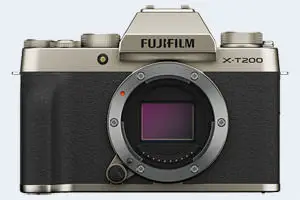Fujifilm X-T200 vs Sony RX100 VII
The Fujifilm X-T200 and the Sony Cyber-shot DSC-RX100 VII are two digital cameras that were revealed to the public, respectively, in January 2020 and July 2019. The X-T200 is a mirrorless interchangeable lens camera, while the RX100 VII is a fixed lens compact. The cameras are based on an APS-C (X-T200) and an one-inch (RX100 VII) sensor. The Fujifilm has a resolution of 24 megapixels, whereas the Sony provides 20 MP.
Below is an overview of the main specs of the two cameras as a starting point for the comparison.

Check X-T200 offers at
ebay.com

Check RX100 VII price at
amazon.com
Going beyond this snapshot of core features and characteristics, what are the differences between the Fujifilm X-T200 and the Sony Cyber-shot DSC-RX100 VII? Which one should you buy? Read on to find out how these two cameras compare with respect to their body size, their imaging sensors, their shooting features, their input-output connections, and their reception by expert reviewers.
Body comparison
The side-by-side display below illustrates the physical size and weight of the Fujifilm X-T200 and the Sony RX100 VII. The two cameras are presented according to their relative size. Three consecutive views from the front, the top, and the rear side are shown. All width, height and depth dimensions are rounded to the nearest millimeter.
The X-T200 can be obtained in three different colors (silver, gold, titanium), while the RX100 VII is only available in black.
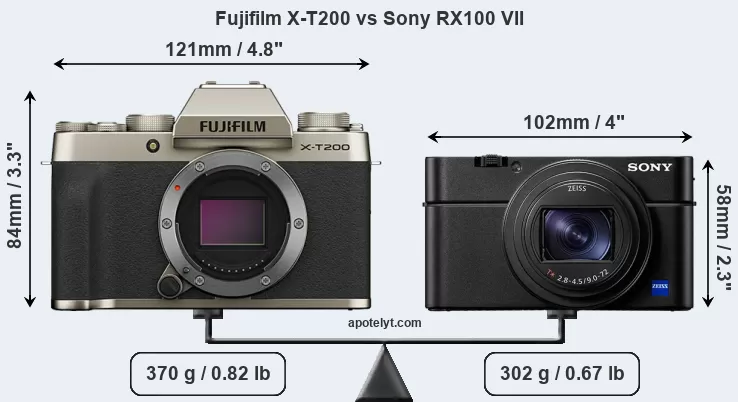
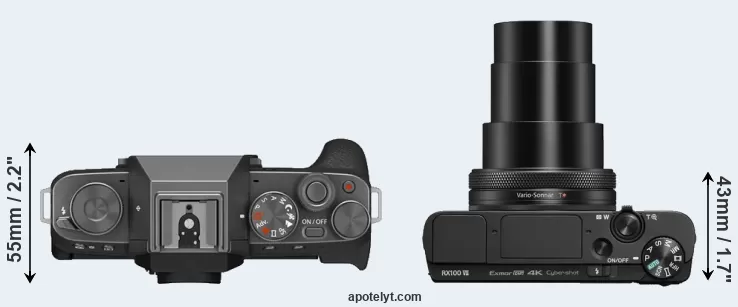
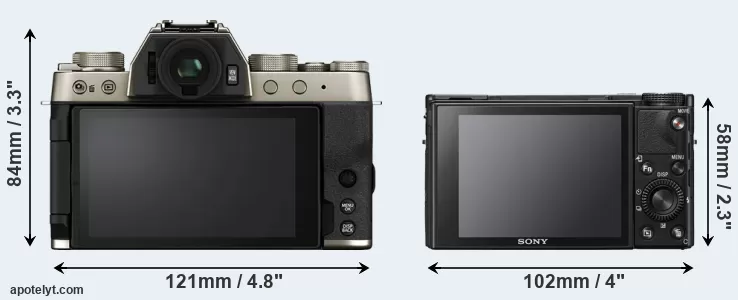
If the front view area (width x height) of the cameras is taken as an aggregate measure of their size, the Sony RX100 VII is considerably smaller (42 percent) than the Fujifilm X-T200. In this context, it is worth noting that neither the X-T200 nor the RX100 VII are weather-sealed.
The above size and weight comparisons are to some extent incomplete and possibly misleading, as the RX100 VII has a lens built in, whereas the X-T200 is an interchangeable lens camera that requires a separate lens. Attaching the latter will add extra weight and bulk to the setup. You can compare the optics available for the X-T200 and their specifications in the Fujinon X Lens Catalog.
Concerning battery life, the X-T200 gets 270 shots out of its Fujifilm NP-W126S battery, while the RX100 VII can take 260 images on a single charge of its Sony NP-BX1 power pack. The battery packs of both cameras can be charged via USB, which can be very convenient when travelling.
The table below summarizes the key physical specs of the two cameras alongside a broader set of comparators. In case you want to display and compare another camera duo, you can use the CAM-parator app to select your camera combination among a large number of options.

| Camera Model |
Camera Width |
Camera Height |
Camera Depth |
Camera Weight |
Battery Life |
Weather Sealing |
Camera Launch |
Launch Price (USD) |
Street Price |
||
|---|---|---|---|---|---|---|---|---|---|---|---|
| 1. | Fujifilm X-T200 | 121 mm | 84 mm | 55 mm | 370 g | 270 | n | Jan 2020 | 699 | ebay.com | |
| 2. | Sony RX100 VII | 102 mm | 58 mm | 43 mm | 302 g | 260 | n | Jul 2019 | 1,199 | amazon.com | |
| 3. | Fujifilm X-A3 | 117 mm | 67 mm | 40 mm | 339 g | 410 | n | Aug 2016 | 399 | ebay.com | |
| 4. | Fujifilm X-A7 | 119 mm | 68 mm | 41 mm | 320 g | 440 | n | Sep 2019 | 499 | ebay.com | |
| 5. | Fujifilm X-E2S | 129 mm | 75 mm | 37 mm | 350 g | 350 | n | Jan 2016 | 699 | ebay.com | |
| 6. | Fujifilm X-E3 | 121 mm | 74 mm | 43 mm | 337 g | 350 | n | Sep 2017 | 899 | ebay.com | |
| 7. | Fujifilm X-E4 | 121 mm | 73 mm | 33 mm | 364 g | 380 | n | Jan 2021 | 849 | amazon.com | |
| 8. | Fujifilm X-T10 | 118 mm | 83 mm | 41 mm | 381 g | 350 | n | May 2015 | 799 | ebay.com | |
| 9. | Fujifilm X-T20 | 118 mm | 83 mm | 41 mm | 383 g | 350 | n | Jan 2017 | 899 | ebay.com | |
| 10. | Fujifilm X-T30 | 118 mm | 83 mm | 47 mm | 383 g | 380 | n | Feb 2019 | 899 | ebay.com | |
| 11. | Fujifilm X-T30 II | 118 mm | 83 mm | 47 mm | 383 g | 380 | n | Sep 2021 | 899 | amazon.com | |
| 12. | Fujifilm X-T100 | 121 mm | 83 mm | 47 mm | 448 g | 430 | n | May 2018 | 599 | ebay.com | |
| 13. | Leica C-LUX | 113 mm | 67 mm | 46 mm | 340 g | 370 | n | Jun 2018 | 1,049 | ebay.com | |
| 14. | Sony RX100 IV | 102 mm | 58 mm | 41 mm | 298 g | 280 | n | Jun 2015 | 999 | ebay.com | |
| 15. | Sony RX100 V | 102 mm | 58 mm | 41 mm | 299 g | 220 | n | Oct 2016 | 999 | ebay.com | |
| 16. | Sony RX100 VI | 102 mm | 58 mm | 43 mm | 301 g | 240 | n | Jun 2018 | 1,199 | ebay.com | |
| 17. | Sony ZV-1 | 105 mm | 60 mm | 44 mm | 294 g | 260 | n | May 2020 | 799 | ebay.com | |
| Note: Measurements and pricing do not include easily detachable parts, such as add-on or interchangeable lenses or optional viewfinders. | |||||||||||
Any camera decision will obviously take relative prices into account. The listed launch prices provide an indication of the market segment that the manufacturer of the cameras have been targeting. Usually, retail prices stay at first close to the launch price, but after several months, discounts become available. Later in the product cycle and, in particular, when the replacement model is about to appear, further discounting and stock clearance sales often push the camera price considerably down. Then, after the new model is out, very good deals can frequently be found on the pre-owned market.
Sensor comparison
The size of the imaging sensor is a crucial determinant of image quality. A large sensor will generally have larger individual pixels that offer better low-light sensitivity, provide wider dynamic range, and have richer color-depth than smaller pixels in a sensor of the same technological generation. Further, a large sensor camera will give the photographer additional creative options when using shallow depth-of-field to isolate a subject from its background. On the downside, larger sensors are more costly to manufacture and tend to lead to bigger and heavier cameras and lenses.
Of the two cameras under consideration, the Fujifilm X-T200 features an APS-C sensor and the Sony RX100 VII an one-inch sensor. The sensor area in the RX100 VII is 69 percent smaller. As a result of these sensor size differences, the cameras have a format factor of, respectively, 1.5 and 2.7. Both cameras have a native aspect ratio (sensor width to sensor height) of 3:2.
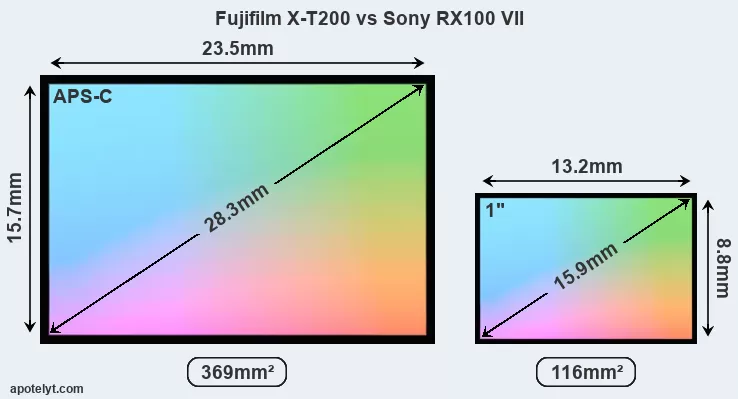
With 24MP, the X-T200 offers a higher resolution than the RX100 VII (20MP), but the X-T200 nevertheless has larger individual pixels (pixel pitch of 3.92μm versus 2.41μm for the RX100 VII) due to its larger sensor. Moreover, the X-T200 is a somewhat more recent model (by 5 months) than the RX100 VII, and its sensor might have benefitted from technological advances during this time that further enhance the light gathering capacity of its pixels.
The resolution advantage of the Fujifilm X-T200 implies greater flexibility for cropping images or the possibility to print larger pictures. The maximum print size of the X-T200 for good quality output (200 dots per inch) amounts to 30 x 20 inches or 76.2 x 50.8 cm, for very good quality (250 dpi) 24 x 16 inches or 61 x 40.6 cm, and for excellent quality (300 dpi) 20 x 13.3 inches or 50.8 x 33.9 cm. The corresponding values for the Sony RX100 VII are 27.4 x 18.2 inches or 69.5 x 46.3 cm for good quality, 21.9 x 14.6 inches or 55.6 x 37.1 cm for very good quality, and 18.2 x 12.2 inches or 46.3 x 30.9 cm for excellent quality prints.
The Fujifilm X-T200 has a native sensitivity range from ISO 200 to ISO 12800, which can be extended to ISO 100-51200. The corresponding ISO settings for the Sony Cyber-shot DSC-RX100 VII are ISO 125 to ISO 12800, with the possibility to increase the ISO range to 80-25600.
In terms of underlying technology, the X-T200 is build around a CMOS sensor, while the RX100 VII uses a BSI-CMOS imager. Both cameras use a Bayer filter for capturing RGB colors on a square grid of photosensors. This arrangement is found in most digital cameras.
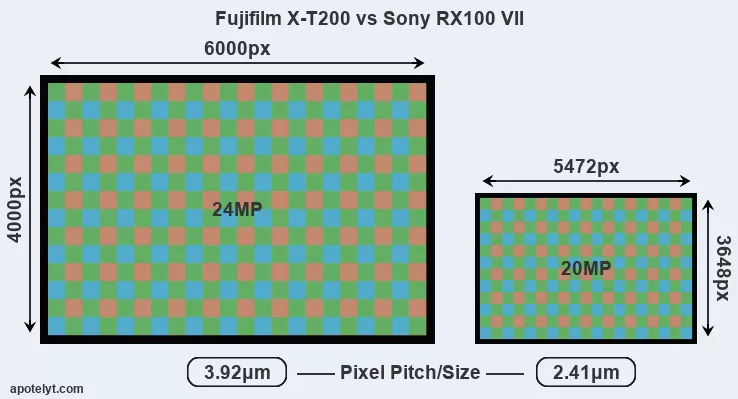
For many cameras, data on sensor performance has been reported by DXO Mark. This service determines an overall sensor rating, as well as sub-scores for low-light sensitivity ("DXO Sports"), dynamic range ("DXO Landscape"), and color depth ("DXO Portrait"). The adjacent table reports on the physical sensor characteristics and the outcomes of the DXO sensor quality tests for a sample of comparator-cameras.

| Camera Model |
Sensor Class |
Resolution (MP) |
Horiz. Pixels |
Vert. Pixels |
Video Format |
DXO Portrait |
DXO Landscape |
DXO Sports |
DXO Overall |
||
|---|---|---|---|---|---|---|---|---|---|---|---|
| 1. | Fujifilm X-T200 | APS-C | 24.0 | 6000 | 4000 | 4K/30p | 24.1 | 13.6 | 1991 | 84 | |
| 2. | Sony RX100 VII | 1-inch | 20.0 | 5472 | 3648 | 4K/30p | 21.8 | 12.4 | 418 | 63 | |
| 3. | Fujifilm X-A3 | APS-C | 24.0 | 6000 | 4000 | 1080/60p | 23.8 | 13.1 | 1664 | 81 | |
| 4. | Fujifilm X-A7 | APS-C | 24.0 | 6000 | 4000 | 4K/30p | 24.1 | 13.6 | 1955 | 84 | |
| 5. | Fujifilm X-E2S | APS-C | 16.0 | 4896 | 3264 | 1080/60p | 23.7 | 13.0 | 1608 | 80 | |
| 6. | Fujifilm X-E3 | APS-C | 24.0 | 6000 | 4000 | 4K/30p | 23.9 | 13.3 | 1764 | 82 | |
| 7. | Fujifilm X-E4 | APS-C | 26.0 | 6240 | 4160 | 4K/30p | 24.2 | 13.7 | 2085 | 85 | |
| 8. | Fujifilm X-T10 | APS-C | 16.0 | 4896 | 3264 | 1080/60p | 23.7 | 12.9 | 1546 | 79 | |
| 9. | Fujifilm X-T20 | APS-C | 24.0 | 6000 | 4000 | 4K/30p | 23.9 | 13.2 | 1704 | 81 | |
| 10. | Fujifilm X-T30 | APS-C | 26.0 | 6240 | 4160 | 4K/30p | 24.1 | 13.5 | 1895 | 83 | |
| 11. | Fujifilm X-T30 II | APS-C | 26.0 | 6240 | 4160 | 4K/30p | 24.2 | 13.8 | 2144 | 85 | |
| 12. | Fujifilm X-T100 | APS-C | 24.0 | 6000 | 4000 | 4K/15p | 24.0 | 13.4 | 1829 | 83 | |
| 13. | Leica C-LUX | 1-inch | 20.0 | 5472 | 3648 | 4K/30p | 22.1 | 12.3 | 481 | 64 | |
| 14. | Sony RX100 IV | 1-inch | 20.0 | 5472 | 3648 | 4K/30p | 22.8 | 12.6 | 591 | 70 | |
| 15. | Sony RX100 V | 1-inch | 20.0 | 5472 | 3648 | 4K/30p | 22.8 | 12.4 | 586 | 70 | |
| 16. | Sony RX100 VI | 1-inch | 20.0 | 5472 | 3648 | 4K/30p | 22.1 | 12.3 | 478 | 64 | |
| 17. | Sony ZV-1 | 1-inch | 20.0 | 5472 | 3648 | 4K/30p | 22.2 | 12.6 | 669 | 66 | |
| Note: DXO values in italics represent estimates based on sensor size and age. | |||||||||||
Many modern cameras are not only capable of taking still images, but can also record movies. Both cameras under consideration have a sensor with sufficiently fast read-out times for moving pictures, and both provide the same movie specifications (4K/30p).
Feature comparison
Apart from body and sensor, cameras can and do differ across a range of features. The two cameras under consideration are similar with respect to both having an electronic viewfinder. However, the one in the X-T200 offers a slightly higher resolution than the one in the RX100 VII (2360k vs 2359k dots). The adjacent table lists some of the other core features of the Fujifilm X-T200 and Sony RX100 VII along with similar information for a selection of comparators.

| Camera Model |
Viewfinder (Type or 000 dots) |
Control Panel (yes/no) |
LCD Specifications (inch/000 dots) |
LCD Attach- ment |
Touch Screen (yes/no) |
Max Shutter Speed * |
Max Shutter Flaps * |
Built-in Flash (yes/no) |
Built-in Image Stab |
||
|---|---|---|---|---|---|---|---|---|---|---|---|
| 1. | Fujifilm X-T200 | 2360 | n | 3.5 / 2780 | swivel | Y | 1/4000s | 8.0/s | Y | n | |
| 2. | Sony RX100 VII | 2359 | n | 3.0 / 921 | tilting | Y | 1/2000s | 90.0/s | Y | Y | |
| 3. | Fujifilm X-A3 | none | n | 3.0 / 1040 | tilting | Y | 1/4000s | 6.0/s | Y | n | |
| 4. | Fujifilm X-A7 | none | n | 3.5 / 2760 | swivel | Y | 1/4000s | 6.0/s | Y | n | |
| 5. | Fujifilm X-E2S | 2360 | n | 3.0 / 1040 | fixed | n | 1/4000s | 7.0/s | Y | n | |
| 6. | Fujifilm X-E3 | 2360 | n | 3.0 / 1040 | fixed | Y | 1/4000s | 8.0/s | n | n | |
| 7. | Fujifilm X-E4 | 2360 | n | 3.0 / 1620 | tilting | Y | 1/4000s | 8.0/s | n | n | |
| 8. | Fujifilm X-T10 | 2360 | n | 3.0 / 920 | tilting | n | 1/4000s | 8.0/s | Y | n | |
| 9. | Fujifilm X-T20 | 2360 | n | 3.0 / 1040 | tilting | Y | 1/4000s | 8.0/s | Y | n | |
| 10. | Fujifilm X-T30 | 2360 | n | 3.0 / 1040 | tilting | Y | 1/4000s | 8.0/s | Y | n | |
| 11. | Fujifilm X-T30 II | 2360 | n | 3.0 / 1620 | tilting | Y | 1/4000s | 8.0/s | Y | n | |
| 12. | Fujifilm X-T100 | 2360 | n | 3.0 / 1040 | swivel | Y | 1/4000s | 6.0/s | Y | n | |
| 13. | Leica C-LUX | 2330 | n | 3.0 / 1240 | fixed | Y | 1/2000s | 10.0/s | Y | Y | |
| 14. | Sony RX100 IV | 2359 | n | 3.0 / 1228 | tilting | n | 1/2000s | 16.0/s | Y | Y | |
| 15. | Sony RX100 V | 2359 | n | 3.0 / 1229 | tilting | n | 1/2000s | 24.0/s | Y | Y | |
| 16. | Sony RX100 VI | 2359 | n | 3.0 / 1229 | tilting | Y | 1/2000s | 24.0/s | Y | Y | |
| 17. | Sony ZV-1 | none | n | 3.0 / 922 | swivel | Y | 1/2000s | 24.0/s | n | n | |
| Note: *) Information refers to the mechanical shutter, unless the camera only has an electronic one. | |||||||||||
The reported shutter speed information refers to the use of the mechanical shutter. Yet, some cameras only have an electronic shutter, while others have an electronic shutter in addition to a mechanical one. In fact, both cameras under consideration feature an electronic shutter, which makes completely silent shooting possible. However, this mode is less suitable for photographing moving objects (risk of rolling shutter) or shooting under artificial light sources (risk of flickering).
The Fujifilm X-T200 and the Sony RX100 VII both have an intervalometer built-in. This enables the photographer to capture time lapse sequences, such as flower blooming, a sunset or moon rise, without purchasing an external camera trigger and related software.
The X-T200 writes its imaging data to SDXC cards, while the RX100 VII uses SDXC or Memory Stick PRO Duo cards. Both cameras can use UHS-I cards, which provide for Ultra High Speed data transfer of up to 104 MB/s.
Connectivity comparison
For some imaging applications, the extent to which a camera can communicate with its environment can be an important aspect in the camera decision process. The table below provides an overview of the connectivity of the Fujifilm X-T200 and Sony Cyber-shot DSC-RX100 VII and, in particular, the interfaces the cameras (and selected comparators) provide for accessory control and data transfer.

| Camera Model |
Hotshoe Port |
Internal Mic / Speaker |
Microphone Port |
Headphone Port |
HDMI Port |
USB Port |
WiFi Support |
NFC Support |
Bluetooth Support |
||
|---|---|---|---|---|---|---|---|---|---|---|---|
| 1. | Fujifilm X-T200 | Y | stereo / mono | Y | Y | micro | 3.1 | Y | - | Y | |
| 2. | Sony RX100 VII | - | stereo / mono | Y | - | micro | 2.0 | Y | Y | Y | |
| 3. | Fujifilm X-A3 | Y | stereo / mono | - | - | micro | 2.0 | Y | - | - | |
| 4. | Fujifilm X-A7 | Y | stereo / mono | Y | - | micro | 2.0 | Y | - | Y | |
| 5. | Fujifilm X-E2S | Y | stereo / mono | Y | - | micro | 2.0 | Y | - | - | |
| 6. | Fujifilm X-E3 | Y | stereo / mono | Y | - | micro | 2.0 | Y | - | Y | |
| 7. | Fujifilm X-E4 | Y | stereo / mono | Y | - | micro | 3.2 | Y | - | Y | |
| 8. | Fujifilm X-T10 | Y | stereo / mono | Y | - | micro | 2.0 | Y | - | - | |
| 9. | Fujifilm X-T20 | Y | stereo / mono | Y | - | micro | 2.0 | Y | - | - | |
| 10. | Fujifilm X-T30 | Y | stereo / mono | Y | - | micro | 3.1 | Y | - | Y | |
| 11. | Fujifilm X-T30 II | Y | stereo / mono | Y | - | micro | 3.2 | Y | - | Y | |
| 12. | Fujifilm X-T100 | Y | stereo / mono | Y | - | micro | 2.0 | Y | - | Y | |
| 13. | Leica C-LUX | - | stereo / mono | - | - | micro | 2.0 | Y | - | - | |
| 14. | Sony RX100 IV | - | stereo / mono | - | - | micro | 2.0 | Y | Y | - | |
| 15. | Sony RX100 V | - | stereo / mono | - | - | micro | 2.0 | Y | Y | - | |
| 16. | Sony RX100 VI | - | stereo / mono | - | - | micro | 2.0 | Y | Y | Y | |
| 17. | Sony ZV-1 | Y | stereo / mono | Y | - | micro | 2.0 | Y | - | Y |
It is notable that the X-T200 has a hotshoe, while the RX100 VII does not. This socket makes it possible to easily attach optional accessories, such as an external flash gun.
The RX100 VII is a recent model that features in the current product line-up of Sony. In contrast, the X-T200 has been discontinued (but can be found pre-owned on ebay). There has not been a direct replacement model for the X-T200 from Fujifilm. Further information on the features and operation of the X-T200 and RX100 VII can be found, respectively, in the Fujifilm X-T200 Manual (free pdf) or the online Sony RX100 VII Manual.
Review summary
So what conclusions can be drawn? Is the Fujifilm X-T200 better than the Sony RX100 VII or vice versa? Below is a summary of the relative strengths of each of the two contestants.

Arguments in favor of the Fujifilm X-T200:
- More detail: Offers more megapixels (24 vs 20MP) with a 10% higher linear resolution.
- Better image quality: Features a larger and more technologically advanced imaging sensor.
- Richer colors: The sensor size advantage translates into images with better, more accurate colors.
- More dynamic range: Larger sensor captures a wider spectrum of light and dark details.
- Better low-light sensitivity: Larger sensor produces good images even in poorly lit environments.
- Better sound control: Has a headphone port that enables audio monitoring while recording.
- Larger viewfinder image: Features a viewfinder with a higher magnification (0.62x vs 0.59x).
- Larger screen: Has a bigger rear LCD (3.5" vs 3.0") for image review and settings control.
- More detailed LCD: Has a higher resolution rear screen (2780k vs 921k dots).
- More flexible LCD: Has a swivel screen for odd-angle shots in portrait or landscape orientation.
- Faster shutter: Has higher mechanical shutter speed (1/4000s vs 1/2000s) to freeze action.
- More flexible: Accepts interchangeable lenses, so that lens characteristics can be altered.
- Better lighting: Features a hotshoe and can thus hold and trigger an external flash gun.
- Faster data transfer: Supports a more advanced USB protocol (3.1 vs 2.0).
- More modern: Is somewhat more recent (announced 5 months after the RX100 VII).

Advantages of the Sony Cyber-shot DSC-RX100 VII:
- Faster burst: Shoots at higher frequency (90 vs 8 flaps/sec) to capture the decisive moment.
- Ready to shoot: Has an integrated lens, whereas the X-T200 necessitates an extra lens.
- More compact: Is smaller (102x58mm vs 121x84mm) and will fit more readily into a bag.
- Less heavy: Has a lower weight even though it has a lens built in (unlike the X-T200).
- Sharper images: Has stabilization technology built-in to reduce the impact of hand-shake.
- Easier device pairing: Supports NFC for fast wireless image transfer over short distances.
- More heavily discounted: Has been on the market for longer (launched in July 2019).
If the number of relative strengths (bullet points above) is taken as a guide, the X-T200 is the clear winner of the match-up (15 : 7 points). However, the pertinence of the various camera strengths will differ across photographers, so that you might want to weigh individual camera traits according to their importance for your own imaging needs before making a camera decision. A professional wildlife photographer will view the differences between cameras in a way that diverges from the perspective of a family photog, and a person interested in architecture has distinct needs from a sports shooter. Hence, the decision which camera is best and worth buying is often a very personal one.
How about other alternatives? Do the specifications of the Fujifilm X-T200 and the Sony RX100 VII place the cameras among the top in their class? Find out in the latest Best Mirrorless Interchangeable Lens Camera and Best Travel-Zoom Camera listings whether the two cameras rank among the cream of the crop.
In any case, while the comparison of the spec-sheets of cameras can offer a general idea of their imaging potential, it remains partial and cannot reveal, for example, the shooting experience and imaging performance when actually working with the X-T200 or the RX100 VII. User reviews, such as those found at amazon, can sometimes inform about these issues, but such feedback is often incomplete, inconsistent, and biased.
Expert reviews
This is why hands-on reviews by experts are important. The table below provides a synthesis of the camera assessments of some of the best known photo-gear review sites (amateurphotographer [AP], cameralabs [CL], digitalcameraworld [DCW], dpreview [DPR], ephotozine [EPZ], photographyblog [PB]). As can be seen, the professional reviewers agree in many cases on the quality of different cameras, but sometimes their assessments diverge, reinforcing the earlier point that a camera decision is often a very personal choice.

| Camera Model |
AP score |
CL score |
DCW score |
DPR score |
EPZ score |
PB score |
Camera Launch |
Launch Price (USD) |
Street Price |
||
|---|---|---|---|---|---|---|---|---|---|---|---|
| 1. | Fujifilm X-T200 | 3.5/5 | .. | 4/5 | 82/100 | 4/5 | 4.5/5 | Jan 2020 | 699 | ebay.com | |
| 2. | Sony RX100 VII | 4.5/5 | .. | 4/5 | .. | 4/5 | 5/5 | Jul 2019 | 1,199 | amazon.com | |
| 3. | Fujifilm X-A3 | .. | .. | .. | 74/100 | 4.5/5 | 4/5 | Aug 2016 | 399 | ebay.com | |
| 4. | Fujifilm X-A7 | 3/5 | .. | 3.5/5 | 81/100 | 4/5 | 3.5/5 | Sep 2019 | 499 | ebay.com | |
| 5. | Fujifilm X-E2S | 4.5/5 | .. | .. | 77/100 | 4.5/5 | 4.5/5 | Jan 2016 | 699 | ebay.com | |
| 6. | Fujifilm X-E3 | 4.5/5 | + | 4.5/5 | 84/100 | 4.5/5 | 4.5/5 | Sep 2017 | 899 | ebay.com | |
| 7. | Fujifilm X-E4 | 4/5 | .. | 4/5 | .. | 4.5/5 | 4/5 | Jan 2021 | 849 | amazon.com | |
| 8. | Fujifilm X-T10 | 4.5/5 | + + | .. | 80/100 | 5/5 | 5/5 | May 2015 | 799 | ebay.com | |
| 9. | Fujifilm X-T20 | 5/5 | + + | 5/5 | 82/100 | 5/5 | 4.5/5 | Jan 2017 | 899 | ebay.com | |
| 10. | Fujifilm X-T30 | 5/5 | + + | 5/5 | 84/100 | 4.5/5 | 4.5/5 | Feb 2019 | 899 | ebay.com | |
| 11. | Fujifilm X-T30 II | 5/5 | .. | 4/5 | .. | 4.5/5 | 4.5/5 | Sep 2021 | 899 | amazon.com | |
| 12. | Fujifilm X-T100 | 4/5 | + | 4.5/5 | 79/100 | 4/5 | 4.5/5 | May 2018 | 599 | ebay.com | |
| 13. | Leica C-LUX | .. | .. | 3.5/5 | .. | 4.5/5 | 4/5 | Jun 2018 | 1,049 | ebay.com | |
| 14. | Sony RX100 IV | 4.5/5 | + + | .. | 85/100 | 4/5 | 4.5/5 | Jun 2015 | 999 | ebay.com | |
| 15. | Sony RX100 V | 4.5/5 | + + | .. | 83/100 | 4/5 | 4.5/5 | Oct 2016 | 999 | ebay.com | |
| 16. | Sony RX100 VI | 4.5/5 | + + | .. | 83/100 | 4/5 | 4.5/5 | Jun 2018 | 1,199 | ebay.com | |
| 17. | Sony ZV-1 | 4/5 | + | 4/5 | 85/100 | 4/5 | 4.5/5 | May 2020 | 799 | ebay.com | |
| Note: (+ +) highly recommended; (+) recommended; (o) reviewed; (..) not available. | |||||||||||
The above review scores should be interpreted with care, though. The assessments were made in relation to similar cameras of the same technological generation. Thus, a score needs to be put into the context of the launch date and the launch price of the camera, and comparisons of ratings among very different cameras or across long time periods have little meaning. Also, kindly note that some of the listed sites have over time developped their review approaches and their reporting style.

Check X-T200 offers at
ebay.com

Check RX100 VII price at
amazon.com
Other camera comparisons
Did this review help to inform your camera decision process? If you would like to see a different side-by-side camera review, just make a corresponding selection in the search boxes below. As an alternative, you can also directly jump to any one of the listed comparisons that were previously generated by the CAM-parator tool.
- Canon 4000D vs Fujifilm X-T200
- Canon 450D vs Sony RX100 VII
- Canon 5D Mark II vs Sony RX100 VII
- Canon G7 X Mark II vs Fujifilm X-T200
- Canon SX730 vs Fujifilm X-T200
- Fujifilm X-T200 vs Sony A7C R
- Fujifilm X-T200 vs Sony RX0
- Fujifilm X-T200 vs Sony ZV-1F
- Nikon D780 vs Sony RX100 VII
- Olympus E-PL1 vs Sony RX100 VII
- Panasonic GH5 II vs Sony RX100 VII
- Sony NEX-5T vs Sony RX100 VII
Specifications: Fujifilm X-T200 vs Sony RX100 VII
Below is a side-by-side comparison of the specs of the two cameras to facilitate a quick review of their differences and common features.
| Camera Model | Fujifilm X-T200 | Sony RX100 VII |
|---|---|---|
| Camera Type | Mirrorless system camera | Fixed lens compact camera |
| Camera Lens | Fujifilm X mount lenses | 24-200mm f/2.8-4.5 |
| Launch Date | January 2020 | July 2019 |
| Launch Price | USD 699 | USD 1,199 |
| Sensor Specs | Fujifilm X-T200 | Sony RX100 VII |
| Sensor Technology | CMOS | BSI-CMOS |
| Sensor Format | APS-C Sensor | 1" Sensor |
| Sensor Size | 23.5 x 15.7 mm | 13.2 x 8.8 mm |
| Sensor Area | 368.95 mm2 | 116.16 mm2 |
| Sensor Diagonal | 28.3 mm | 15.9 mm |
| Crop Factor | 1.5x | 2.7x |
| Sensor Resolution | 24 Megapixels | 20 Megapixels |
| Image Resolution | 6000 x 4000 pixels | 5472 x 3648 pixels |
| Pixel Pitch | 3.92 μm | 2.41 μm |
| Pixel Density | 6.50 MP/cm2 | 17.18 MP/cm2 |
| Moiré control | Anti-Alias filter | Anti-Alias filter |
| Movie Capability | 4K/30p Video | 4K/30p Video |
| ISO Setting | 200 - 12,800 ISO | 125 - 12,800 ISO |
| ISO Boost | 100 - 51,200 ISO | 80 - 25,600 ISO |
| DXO Sensor Quality (score) | .. | 63 |
| DXO Color Depth (bits) | .. | 21.8 |
| DXO Dynamic Range (EV) | .. | 12.4 |
| DXO Low Light (ISO) | .. | 418 |
| Screen Specs | Fujifilm X-T200 | Sony RX100 VII |
| Viewfinder Type | Electronic viewfinder | Electronic viewfinder |
| Viewfinder Field of View | 100% | 100% |
| Viewfinder Magnification | 0.62x | 0.59x |
| Viewfinder Resolution | 2360k dots | 2359k dots |
| LCD Framing | Live View | Live View |
| Rear LCD Size | 3.5inch | 3.0inch |
| LCD Resolution | 2780k dots | 921k dots |
| LCD Attachment | Swivel screen | Tilting screen |
| Touch Input | Touchscreen | Touchscreen |
| Shooting Specs | Fujifilm X-T200 | Sony RX100 VII |
| Focus System | On-Sensor Phase-detect | On-Sensor Phase-detect |
| Manual Focusing Aid | Focus Peaking | Focus Peaking |
| Max Shutter Speed (mechanical) | 1/4000s | 1/2000s |
| Continuous Shooting | 8 shutter flaps/s | 90 shutter flaps/s |
| Electronic Shutter | up to 1/32000s | up to 1/32000s |
| Time-Lapse Photography | Intervalometer built-in | Intervalometer built-in |
| Fill Flash | Built-in Flash | Built-in Flash |
| Storage Medium | SDXC cards | MS or SDXC cards |
| Single or Dual Card Slots | Single card slot | Single card slot |
| UHS card support | UHS-I | UHS-I |
| Connectivity Specs | Fujifilm X-T200 | Sony RX100 VII |
| External Flash | Hotshoe | no Hotshoe |
| USB Connector | USB 3.1 | USB 2.0 |
| HDMI Port | micro HDMI | micro HDMI |
| Microphone Port | External MIC port | External MIC port |
| Headphone Socket | Headphone port | no Headphone port |
| Wifi Support | Wifi built-in | Wifi built-in |
| Near-Field Communication | no NFC | NFC built-in |
| Bluetooth Support | Bluetooth built-in | Bluetooth built-in |
| Body Specs | Fujifilm X-T200 | Sony RX100 VII |
| Battery Type | Fujifilm NP-W126S | Sony NP-BX1 |
| Battery Life (CIPA) | 270 shots per charge | 260 shots per charge |
| In-Camera Charging | USB charging | USB charging |
| Body Dimensions |
121 x 84 x 55 mm (4.8 x 3.3 x 2.2 in) |
102 x 58 x 43 mm (4.0 x 2.3 x 1.7 in) |
| Camera Weight | 370 g (13.1 oz) | 302 g (10.7 oz) |

Check X-T200 offers at
ebay.com

Check RX100 VII price at
amazon.com
Did you notice an error on this page? If so, please get in touch, so that we can correct the information.
